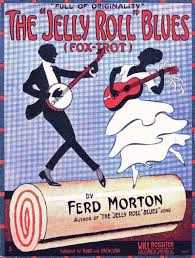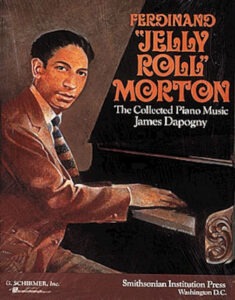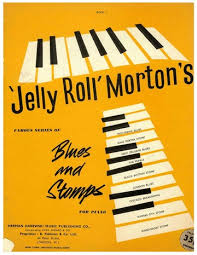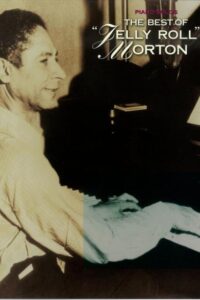Come join us now, and enjoy playing your beloved music and browse through great scores of every level and styles!
Can’t find the songbook you’re looking for? Please, email us at: sheetmusiclibrarypdf@gmail.com We’d like to help you!
Table of Contents

Search your favorite sheet music in the Sheet Music Catalog

Please, subscribe to our Library.
If you are already a subscriber, please, check our NEW SCORES’ page every month for new sheet music. THANK YOU!
Remembering Jelly Roll Morton, born on this day in 1890.
Jelly Roll Morton is a colossal figure in the history of jazz, a pivotal artist who stood at the crossroads of its creation and its first great flowering. To understand him is to understand the very transformation of early 20th-century American music.
Who Was Jelly Roll Morton?
Ferdinand “Jelly Roll” Morton (born Ferdinand Joseph LaMothe, c. 1890 – 1941) was a virtuoso pianist, a brilliant composer, and a formidable bandleader. He was a key figure in the transition from ragtime to what we now recognize as early jazz.
Morton was a complex and flamboyant character. He was a sharp dresser, a notorious braggart (famously claiming to have “invented jazz” in 1902), and a pool hustler, but beneath this larger-than-life persona was a musical genius of the highest order. He was a Creole of color, born in New Orleans, the cradle of jazz, and he absorbed all the diverse musical sounds of the city—from French and Spanish classical and opera to ragtime, blues, spirituals, and the brass band marches that filled the streets.

Browse in the Library:
Or browse in the categories menus & download the Library Catalog PDF:
Why He Is So Important and Influential
Jelly Roll Morton’s importance cannot be overstated. He was not merely a performer; he was jazz’s first true architect.
1. The First Significant Jazz Composer
While jazz is renowned for its improvisation, Morton demonstrated that it could also be a sophisticated composed art form. He didn’t just play tunes; he crafted intricate, multi-thematic pieces with clear beginnings, developmental sections, and endings.
- Compositional Mastery: His compositions like “King Porter Stomp,” “Wolverine Blues,” “The Pearls,” “Black Bottom Stomp,” and “Grandpa’s Spells” became jazz standards and foundational texts for the genre. “King Porter Stomp,” in particular, became a massive hit for the Swing Era big bands of the 1930s, like Benny Goodman’s, proving Morton’s music was decades ahead of its time.
2. The Innovator of Arrangement: The “Jelly Roll” Sound

This is perhaps his most critical contribution. Morton was the first to conceptualize and successfully notate the sound of a jazz ensemble. He moved beyond the solo piano tradition and created a new role: the arranger.
His work with his band, the Red Hot Peppers, for a series of legendary 1926 recordings for the Victor label, is a masterclass in arranged collective improvisation. He didn’t let his musicians just “jam.” He carefully structured his recordings to include:
- Textural Variety: Shifting seamlessly from full ensemble passages to small-group duets and trios, and powerful solo breaks.
- Call and Response: Between the frontline instruments (trumpet, clarinet, trombone) and the rhythm section.
- The “Spanish Tinge”: Morton’s term for the habanera rhythm and other Latin influences he deliberately incorporated, giving his music a unique, cosmopolitan flavor (evident in pieces like “The Crave” and “New Orleans Blues”).
These recordings are considered the first truly coherent and complex jazz ensemble recordings, balancing the spontaneity of improvisation with the discipline of a written arrangement.
3. A Bridge Between Musical Worlds
Morton’s style was a perfect synthesis of the key ingredients of early jazz:
- The Structure of Ragtime: He used the multi-thematic forms of ragtime but loosened the rigid, “oom-pah” rhythm.
- The Emotion of the Blues: He infused his music with blue notes and the raw emotional expression of the blues.
- The Improvisational Spirit of Jazz: He freed the right hand for melodic improvisation while maintaining a strong, swinging rhythmic foundation in the left hand.
On piano, he was a direct link between the ragtime masters like Scott Joplin and the Harlem “stride” pianists like James P. Johnson and Fats Waller.
4. An Invaluable Historical Witness
In 1938, the folklorist Alan Lomax recorded a series of interviews with Morton for the Library of Congress. Over several hours, Morton played his music, told stories, and described the vibrant musical culture of turn-of-the-century New Orleans. These recordings are an irreplaceable oral history of jazz’s birth, told by one of its most important creators.
Legacy and Influence
While his career waned with the rise of the big band Swing Era (his style was considered “old-fashioned” by the late 1930s), his influence is woven into the fabric of jazz.
- Compositional Legacy: His compositions remain essential learning for jazz musicians.
- The Art of Arrangement: His concepts of arranging for a small jazz ensemble directly influenced countless later arrangers and bandleaders, from Duke Ellington to Charles Mingus.
- Piano Technique: His piano style is a cornerstone of the jazz piano tradition.
In summary, Jelly Roll Morton was not merely a participant in early jazz; he was its first great theorist and composer. While he didn’t single-handedly “invent” jazz, he was the first to refine its raw elements into a sophisticated, powerful, and repeatable art form. His genius lay in his ability to capture the wild, polyphonic spirit of a New Orleans street parade and translate it into a structured, yet thrilling, musical masterpiece.
Awards and honors
The Music Box interviews were released posthumously as boxed set and won two Grammy Awards.
- During the same year, Morton was honored with the Grammy Lifetime Achievement Award.
Morton was posthumously nominated in 1992 for the Tony Award for Best Original Score for the musical depicting his life, Jelly’s Last Jam. Morton was inducted in the Rock and Roll Hall of Fame and was elected as a charter member of the Gennett Records Walk of Fame. He was inducted into the Louisiana Music Hall of Fame in 2008.
Discography
- 1923–24 – 1923/24 (Milestone, 1974)
- 1926–27 – Birth Of The Hot – The Classic Chicago “Red Hot Peppers” Sessions (1926-1927) (RCA Bluebird, 1985)
- 1926–1928 – The Pearls (RCA Bluebird, 1988)
- 1926–28 – Jazz King of New Orleans (RCA Bluebird, 1961)
- 1939-40 – Jelly Roll Morton: The Complete Library of Congress Recordings, Vols. 1–8 (8-CD Box Set) (Rounder, 2005)
Form and compositions
Morton’s piano style was formed from early secondary ragtime and “shout”, which also evolved separately into the New York school of stride piano. Morton’s playing was also close to barrelhouse, which produced boogie-woogie.
Morton often played the melody of a tune with his right thumb, while sounding a harmony above these notes with the fingers of the right hand. This could add a rustic or “out-of-tune” sound due to the playing of a diminished 5th above the melody. This technique may still be recognized as belonging to New Orleans. Morton also walked in major and minor sixths in the bass, instead of tenths or octaves. He played basic swing rhythms with both the left and the right hand.
Several of Morton’s compositions were musical tributes to himself, including “Winin’ Boy”, “The Jelly Roll Blues” (subtitled “The Original Jelly-Roll”); and “Mr. Jelly Lord”. In the big-band era, his “King Porter Stomp”, which Morton had written decades earlier, was a big hit for Fletcher Henderson and Benny Goodman; it became a standard covered by most other swing bands of that time. Morton claimed to have written some tunes that were copyrighted by others, including “Alabama Bound” and “Tiger Rag“. “Sweet Peter”, which Morton recorded in 1926, appears to be the source of the melody of the hit song “All of Me“, which was credited to Gerald Marks and Seymour Simons in 1931.
His musical influence continues in the work of Dick Hyman and Reginald Robinson.
Browse in the Library:
Or browse in the categories menus & download the Library Catalog PDF:
